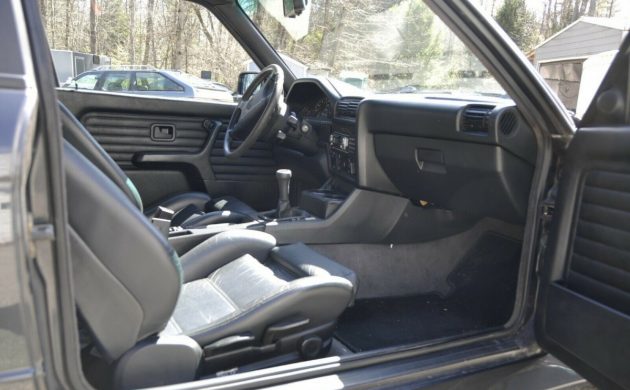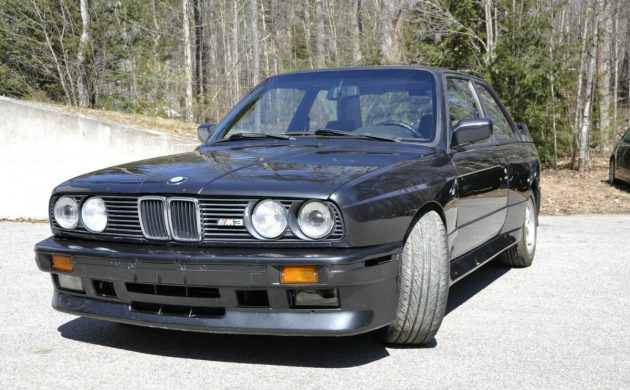Bavarian Barnstormer: 1990 BMW M3
During the 1980s, International Group A Touring Car Racing was second only to Formula 1 in popularity throughout Europe and the Asia/Pacific region. Manufacturer involvement was high, with marques such as Jaguar, Rover, Toyota, Maserati, Nissan, General Motors (Holden), Alfa Romeo, Ford, Mitsubishi, and BMW all having factory involvement in the category. BMW eventually homologated three separate models for the category, being the 635 CSi, the 325i, and the E30 M3. The M3 was a very different creature to the 635 and the 325. Where the 635 and 325 were road cars that were modified for racing duties, the M3 was designed specifically for competition, and then de-tuned for use as a road car. The M3 became an enormous sales and marketing success after initially being released in 1986. The E30 version remained in production until 1992, when it was finally replaced by the E36 M3. This 1990 model M3 is a fairly solid looking example, which is located in Durham, New Hampshire. It is listed for sale here on eBay, and with bidding currently sitting at $21,100, the reserve hasn’t been met.
When it first broke cover, many people thought that the M3 was just a garden variety 3-Series with some fender flares and spoilers. Nothing could be further from the truth. In fact, the regular 3-Series and the M3 only shared a common hood, roof, and inner door panels. Every other panel was specifically designed for the M3, with a number of panels being manufactured from plastic or composite materials. This was done to reduce overall vehicle weight, and to lower the vehicle’s center of gravity. The fender flares were designed to allow for the M3’s wider track when compared to a normal 3-Series and to allow fitment of the largest tires permitted under the Group A regulations, while the spoilers were designed to provide down-force and aerodynamic stability. The body of this M3 looks pretty good, with only a few scrapes and marks on the paintwork. It also looks like there are only a few very minor rust issues, while the original spoilers and body skirts are also present, and in reasonable condition. The hardest thing to replace will be the lenses for the fog-lights in the front spoiler, because not only are they very prone to damage, but replacements might require a bit of patience to locate.
The interior of the M3 is starting to show its age in a few places, but it really isn’t too bad. The steering wheel is quite badly worn, while there is an aftermarket stereo fitted to the car. The leather seats look like they could do with a dose of a quality conditioner, but overall, it really isn’t too bad. Those bucket seats are some of the most comfortable in the business, and they are obviously designed to hold you firmly in place during hard cornering, which is a big part of what this car is all about.
It was under the hood where BMW sprung the biggest surprise on the motoring and racing world. When the first spy photos and rumors about the car surfaced, conventional wisdom said that BMW would follow the lead of a number of other manufacturers involved in Group A by heading down the turbocharged path. This made sense, as BMW was still building the 1.5-liter turbo engine that was being used successfully in Formula 1, and a detuned version would still have been capable of producing a reliable 400hp in Group A form. Instead, BMW opted for a normally-aspirated 2.3-liter 4-cylinder engine. That engine still proved to be a giant killer, with the M3 securing numerous championship wins across the globe. BMW also made a significant number of changes to suspension components and pickup points on the M3 when compare to a regular 3-Series, and these were all designed exclusively with racing in mind. Unfortunately, the 2.3 under the hood of this M3 is not an engine that has a happy tale to tell. It currently has around 158,000 miles under its belt. However, that’s not the worst of the news. The owner was driving it close to the red-line when it suffered a timing chain failure. This is bad news on the M3 engine, and the owner does say that pistons and valve did become fairly closely acquainted. There’s a pretty good chance that this damage will be terminal, and that the engine will probably need replacement. At best, it will need a rebuild, including new pistons and valves, although, if the cylinder head has escaped damage, then that will be a miracle. What makes this worse is the fact that these engines are becoming more difficult to source, and that means prices can be pretty astronomical. It is possible to swap some later engines into an E30 M3, but that will destroy the vehicle’s originality. Still, it might be the only option available to the new owner if the original engine is beyond help.
So, what to do with this BMW M3. This is a tough one because the body looks to be in pretty reasonable condition, and restoring that side of the car doesn’t look like a particularly hard job. However, the engine might be another story altogether, There are certainly some transplant options, so it will be interesting to see what ideas our readers come up with.
Auctions Ending Soon
 2006 Ford Mustang Saleen S281 SCBid Now5 hours$16,000
2006 Ford Mustang Saleen S281 SCBid Now5 hours$16,000
 2002 Subaru Impreza WRXBid Now3 days$333
2002 Subaru Impreza WRXBid Now3 days$333
 1975 Chevrolet Corvette ConvertibleBid Now3 days$3,000
1975 Chevrolet Corvette ConvertibleBid Now3 days$3,000
 1964 Ford F-100 Camper CustomBid Now3 days$2,000
1964 Ford F-100 Camper CustomBid Now3 days$2,000
 2006 Jeep Wrangler SportBid Now5 days$10,500
2006 Jeep Wrangler SportBid Now5 days$10,500






Comments
When you can sell a twenty nine year old E30 M3 with a blown engine for more than 21 grand, the E30 M 3’s are approaching or have surpassed P car mania. Just sayin. When these were six grand and running I wish I had been smart enough to buy and hold on to one.Oh well……….
Saw an episode of “Car Fix” Saturday that featured one of these — same color — but fitted with a six-cylinder. Don’t know if the previous engine suffered catastrophic failure.
Drool. Me want.
BF wrote
“During the 1980s, International Group A Touring Car Racing was second only to Formula 1 in popularity throughout Europe and the Asia/Pacific region”
Well yeah maybe except it was 3rd behind rallying. This was during group B’s heyday and the crowds and popularity were exceeding F1 much to the chagrin of the FIA folks.
Going back to this car. Given the current price of these it is probably priced about right. If the engine is fixed it becomes worth about 35 to 40k.
Fixing the engine is going to be tricky but not impossible. The bottom end is going to be the easy part. As long as there is not a hole in the block it can be repaired. It may need to be bored or even sleeved but not a big deal. Worst case scenario is that it is destroyed. The block is the same as a 320 is. Different internals but same block, piston and rods are available, I don’t know about the crank.
The part that makes it an M is the head, and these can be fixed. I worked on an early euro M5 that had broken a chain and dropped a valve or two. When one of the valve dropped the collet let go and dropped the stem into the cylinder. When the piston came up it punched a nice hole in the head with the stem, along with damage from the head of the valve. Through a lot of welding and machining the head was repaired. Not cheap but it can be done. The early M cars had single row chains and BMW did switch to double row because of failures like this. The car here had a double row chain which rarely fail and I wonder what happened.
When repaired this car is probably worth 35 to 40k and they continue to go up, so there is room to play.
Up to 10K for a reputable (warrantied) rebuild of the S14 engine or the other option would b to make a Hartge 3.5 clone but probably best to find a E36-E46 MPower six for superior reliability just keep the original parts